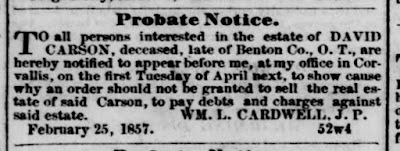A few days ago the Oregon Historical Society published a post on Letitia Carson, "the only known Black woman in Oregon to successfully secure a land claim."
 |
| via Twitter |
The post drew on materials from the Letitia Carson Digital History Collection. Buried in the collection was a receipt from Asahel Bush to the main villain of the story, Greenberry Smith, for advertising Carson's estate, which Smith had seized.*
 |
| Receipt from Asahel Bush for ads, Oct 10th, 1854 |
I couldn't find those ads in late 1854, but here is another series of ads in the Statesman from a little more than two years later.
 |
| March 10th, 1857 |
 |
| April 28th, 1857 |
The time line on these is very interesting.
From Black in Oregon: 1840 - 1870:
Letitia sued David’s estate [administered by Greenberry Smith] twice in a Benton County court in an effort to recover an equitable portion of their property for herself and her children. On May 12, 1855, a jury of Letitia Carson’s former Benton County peers (all white males) determined that Letitia was due $300 for her services to David Carson and another $229.50 to cover court costs and legal fees. Sixteen months later, on October 25, 1856, a federal judge and local jury awarded her an additional $1399.75, including $199.75 for costs and fees, for the unlawful sale of her cattle.
So it looks like the receipt precedes the judgements in the two lawsuits, and the ads follow them. She did not fully recover the estate, however, and the ads from 1857 appear to represent the interests of Greenberry Smith rather than the interests of Letitia Carson.
From the Letitia Carson Digital History Collection:
Although Letitia had won her legal battles and received some compensation, she and her children would never again live on the Soap Creek Valley land they had shared with David Carson. Instead, Letitia continued to raise her family in Douglas County. On June 17, 1863, she filed a claim for 154 acres in Douglas County under the federal 1862 Homestead Act. Unlike the Donation Land Claim Act, Black Americans were eligible to file Homestead Act claims. Interestingly, Letitia filed as a “widow”, rather than as a former slave. In 1868, Letitia’s claim was certified, making her the first Black woman to successfully file a Homestead Act claim in Oregon.
If the 1857 ads ran after the lawsuits and represented the interests of Greenberry Smith, Bush might well have known they were tainted. The Oregon Territory didn't have that many people, and the Judge in the case, George H. Williams, would have been known to Bush. Given what we know of Bush's racism, he would have been very ok with supporting Smith over Carson.
This is potentially a real example of the way Bush supported white supremacy, not just in the expression of objectionable sentiment, but more concretely as action on wealth, property, and power.
 |
| May 2022 |
Hopefully as the Bush House reassesses the legacy of Asahel Bush, we will learn more about things like this. In many ways what Bush might have said, however objectionable and demeaning, is often less interesting than the way he actually exercised power and influence, what he and his businesses actually did.
For previous notes on Asahel Bush see here.
* It should be noted that the Carsons also participated in the larger, systemic seizure of settler colonialism. Letitia was Black, a woman, and a settler. Her daughter, Martha Jane, moved to the Umatilla Reservation later in the 1880s and had married the son of a Walla Walla mother. The Carsons story has been mostly told as Black history, but not so much from any standpoint of Native history. There is much more to learn. (Artist James Lavadour appears to be a descendant, also!)
The Federal Judge in the Carson cases, George H. Williams, is also interesting here. In 2019 OHQ published "Constitutionalizing Racism: George H. Williams’s Appeal for a White Utopia," a discussion of a letter published in the Statesman from 1857, not long after the Carson cases. Williams went on to be Ulysses S. Grant's Attorney General. He has a complicated and interesting history on race, and this deserves more attention in more popular treatments (it may be discussed in academic papers).
See also:
- At OSU, the Letitia Carson Legacy Project (distinct from the Letitia Carson Digital History Collection).
- At the BLM, "From slave to landowner: The grit and gumption of Letitia Carson," with more on her Homestead claim in southern Oregon particularly.
- At Wikipedia generally
- And a little over a year ago, at Salem Reporter, "Grant will help tell story of Black Oregon homesteader who sued to keep her land, livestock."


3 comments:
(Edit: Added link to Salem Reporter piece, which I had forgot about.)
Yesterday Salem Reporter published a piece on new portraits to be installed at Bush House of Ben Johnson and Beatrice Morrow Cannady, two important Black Oregonians. But they don't appear to have much if any connection to Salem or to Asahel Bush. Johnson lived in Jackson County, and Cannady was the editor of a Portland newspaper. It's Black history in general rather than any contribution to a history of Asahel Bush specifically and racism in Salem or to Black history in Salem. It's an odd selection.
I don’t think it is odd. We visited the museum today. The portraits are well done. Since there were so few blacks even allowed in Salem there doesn’t need to be a connection.
Post a Comment